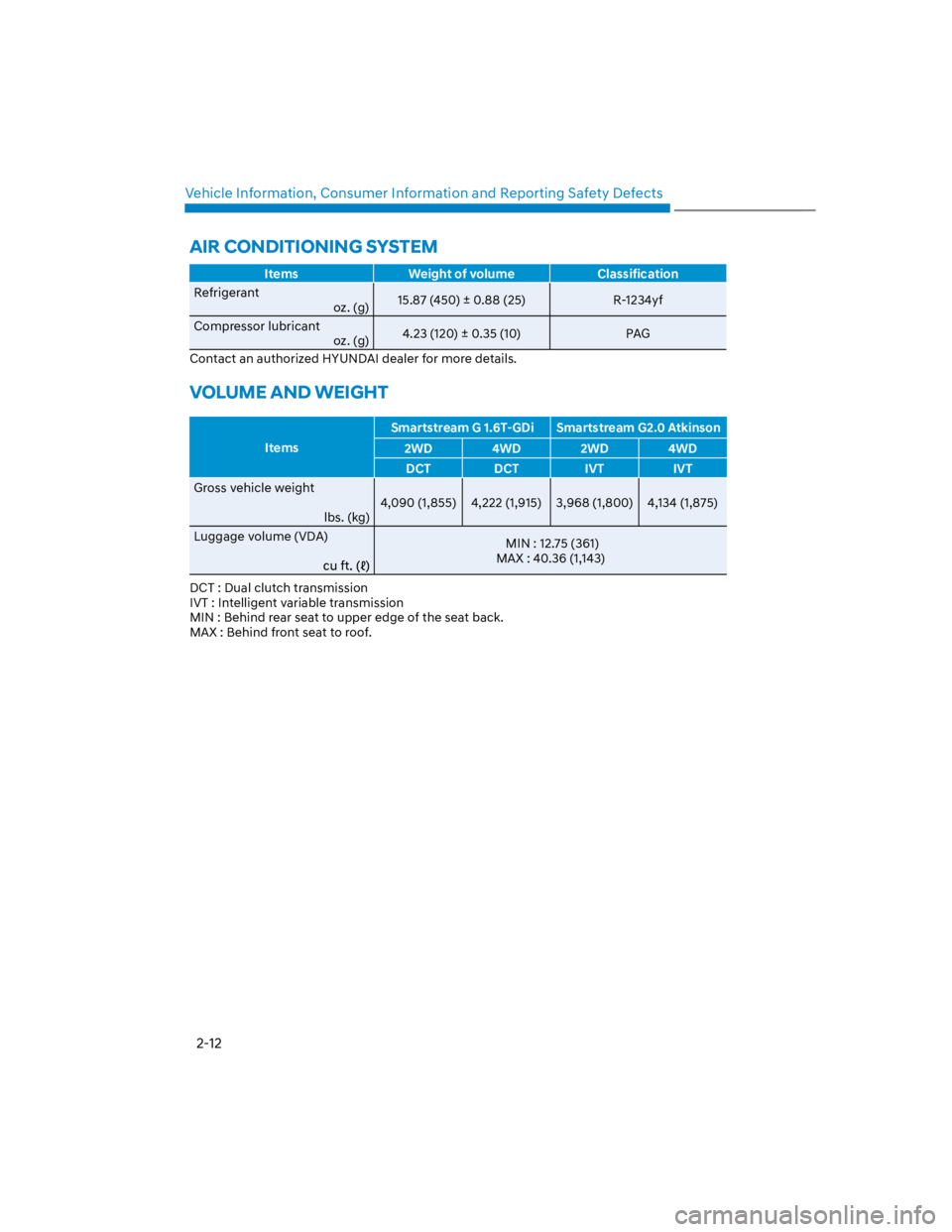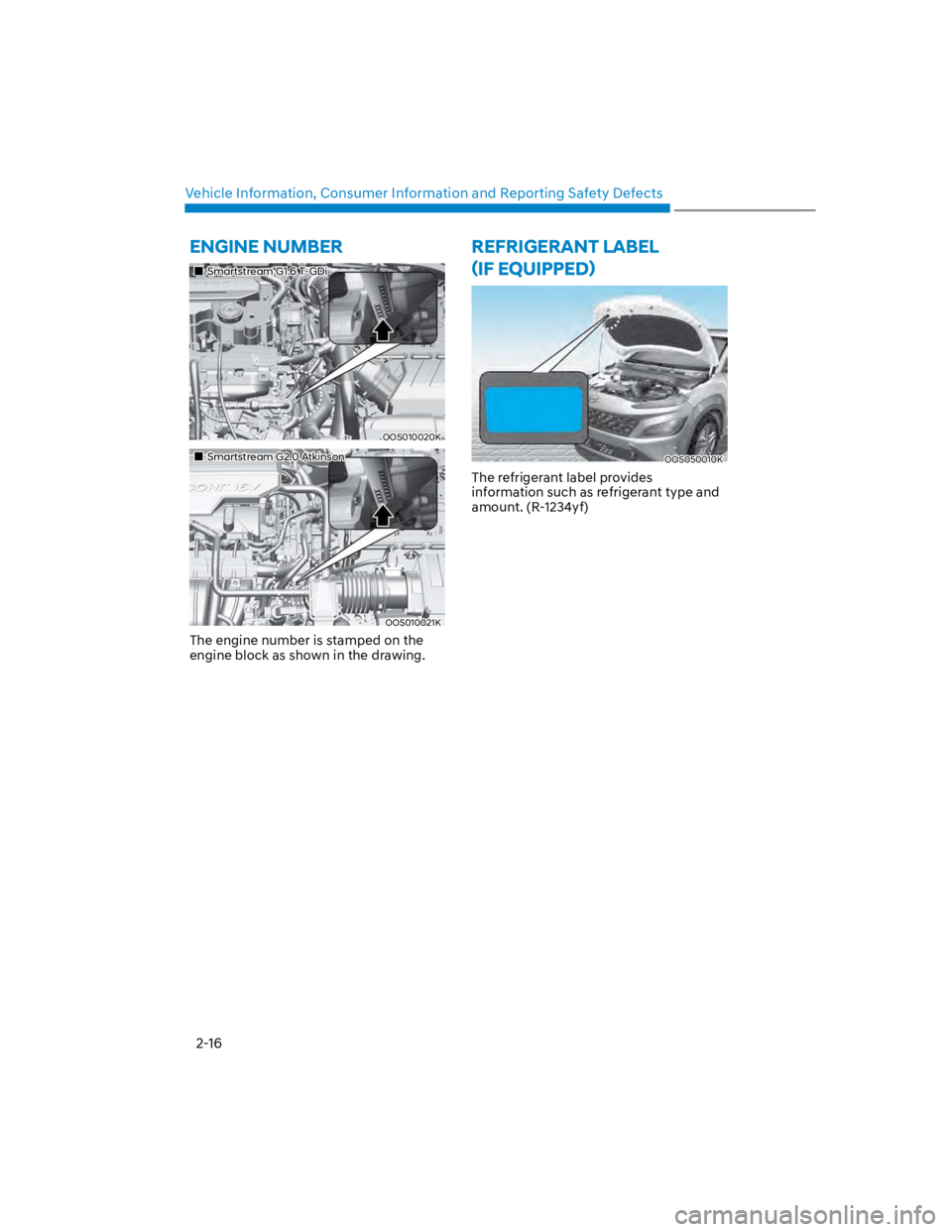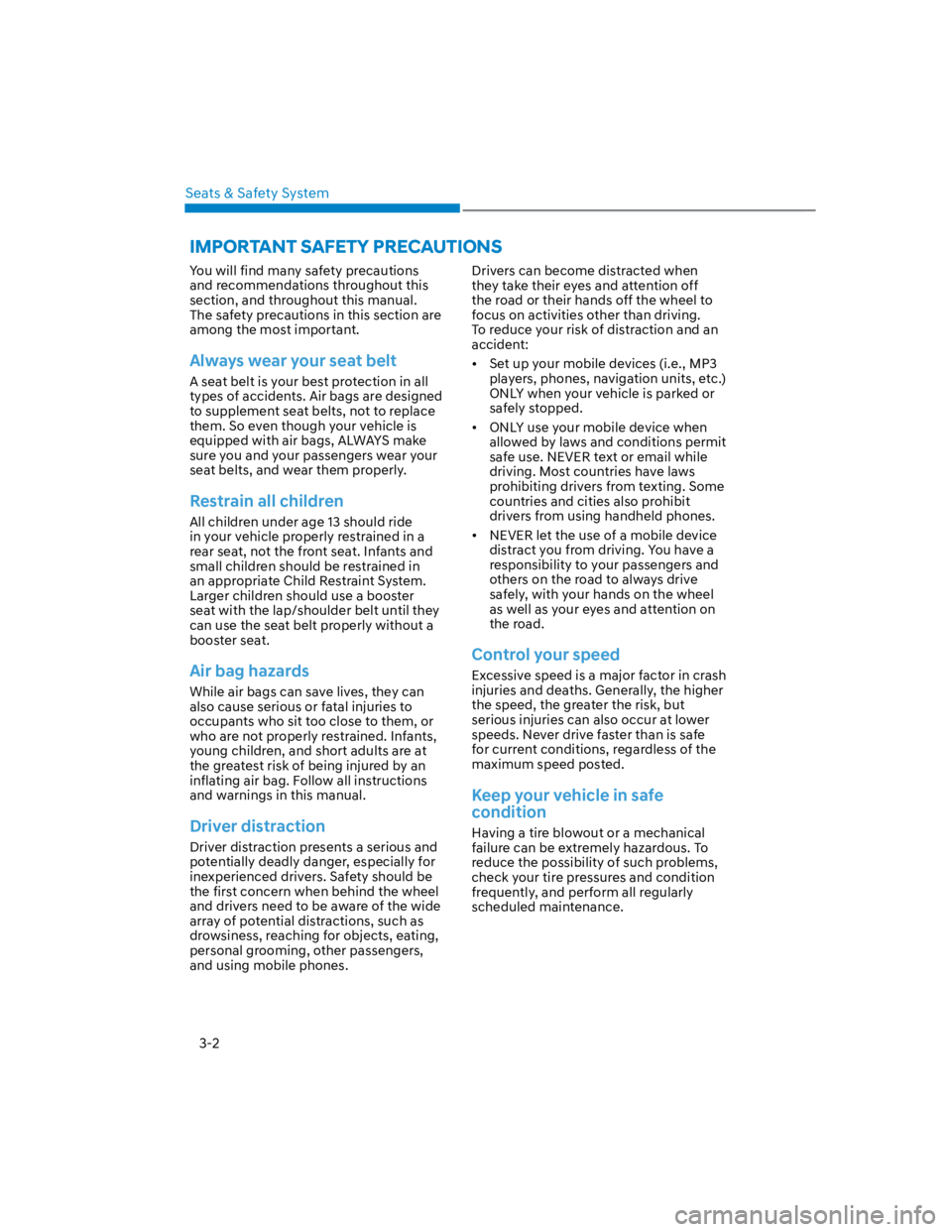2022 HYUNDAI KONA safety
[x] Cancel search: safetyPage 25 of 579

Vehicle Information, Consumer Information and Reporting Safety Defects
2-12
Items Weight of volume Classification
Refrigerant
oz. (g)15.87 (450) ± 0.88 (25) R-1234yf
Compressor lubricant
oz. (g)4.23 (120) ± 0.35 (10) PAG
Contact an authorized HYUNDAI dealer for more details.
VOLUME AND WEIGHT
Items
Smartstream G 1.6T-GDi Smartstream G2.0 Atkinson
2WD 4WD 2WD 4WD
DCT DCT IVT IVT
Gross vehicle weight
lbs. (kg)
4,090 (1,855) 4,222 (1,915) 3,968 (1,800) 4,134 (1,875)
Luggage volume (VDA) MIN : 12.75 (361)
MAX : 40.36 (1,143)
DCT : Dual clutch transmission
IVT : Intelligent variable transmission
MIN : Behind rear seat to upper edge of the seat back.
MAX : Behind front seat to roof.
AIR CONDITIONING SYSTEM
Page 27 of 579

Vehicle Information, Consumer Information and Reporting Safety Defects
2-14
Lubricant Volume Classification
Transfer case oil (4WD)
Smartstream
G1.6 T-GDi
0.49~0.55 US qt.
(0.47~0.52 )HYPOID GEAR OIL API GL-5,
SAE 75W85(SK HCT-5 GEAR
OIL 75W85 or EQUIVALENT)Smartstream
G2.0 Atkinson
0.4 ~ 0.44 US qt.
Brake fluid0.5 ~ 0.6 US qt.
(0.7 ~ 0.8 )
SAE J1704 DOT-4 LV,
FMVSS 116 DOT-4,
ISO4925 CLASS-6
Fuel13.21 US gal.
(50 )
Refer to “Fuel Requirements”
in the Introduction chapter.
Recommended SAE viscosity number
CAUTION
Always be sure to clean the area around any filler plug, drain plug, or dipstick before
checking or draining any lubricant. This is especially important in dusty or sandy
areas and when the vehicle is used on unpaved roads. Cleaning the plug and dipstick
areas will prevent dirt and grit from entering the engine and other mechanisms that
could be damaged.
Engine oil viscosity (thickness) has an effect on fuel economy and cold weather
operating (engine start and engine oil flowability). Lower viscosity engine oils can
provide better fuel economy and cold weather performance, however, higher viscosity
engine oils are required for satisfactory lubrication in hot weather. Using oils of any
viscosity other than those recommended could result in engine damage.
When choosing an oil, consider the range of temperature your vehicle will be operated
in before the next oil change. Proceed to select the recommended oil viscosity from
the chart.
Temperature Range for SAE Viscosity Numbers
Temperature°C -30 -20 -10 0 10 20 30 40 50
(°F) -10 0 20 40 60 80 100 120
Engine Oil
Smartstream
G1.6 T-GDI
/Smartstream
G2.0 Atkinson
0W-200W-20
Page 29 of 579

Vehicle Information, Consumer Information and Reporting Safety Defects
2-16
ENGINE NUMBER
Smartstream G1.6 T-GDi
OOS010020K
Smartstream G2.0 Atkinson
OOS010021K
The engine number is stamped on the
engine block as shown in the drawing.
REFRIGERANT LABEL
OOS050010K
The refrigerant label provides
information such as refrigerant type and
amount. (R-1234yf)
Page 30 of 579

02
2-17
This consumer information has been prepared in accordance with regulations issued
by the National Highway Traffic Safety Administration of the U.S. Department of
Transportation.Your HYUNDAI dealer will help answer any questions you may have as
you read this information.
HYUNDAI motor vehicles are designed and manufactured to meet or exceed all
applicable safety standards.
For your safety, however, we strongly urge you to read and follow all directions in
this Owner’s Manual, particularly the information under the headings “NOTICE”,
“CAUTION” and “WARNING”.
If, after reading this manual, you have any questions regarding the operation of your
vehicle, please contact the Hyundai Customer Care Center.
Hyundai Customer Care
P.O. Box 20850
Fountain Valley, CA 92728
800-633-5151
[email protected]
Hyundai’s Customer Care representatives are available Monday through Friday,
between the hours of 6:00 AM and 5:00 PM PST
and Saturday between 6:30 AM and 3:00 PM PST (English).
For Customer Care assistance in Spanish or Korean, representatives are available
Monday through Friday between 6:30 AM and 3:00 PM PST.
CONSUMER INFORMATION
Page 31 of 579

Vehicle Information, Consumer Information and Reporting Safety Defects
2-18
If you believe that your vehicle has a defect which could cause a crash or
could cause injury or death, you should immediately inform the National
Highway Traffic Safety Administration (NHTSA) in addition to notifying
HYUNDAI MOTOR AMERICA.
To contact NHTSA, you may call the Vehicle Safety Hotline toll-free at 1-888-
327-4236 (TTY: 1-800-424-9153);
go to http://www.safercar.gov;
download the SaferCar mobile application;
or write to: Administrator, NHTSA
1200 New Jersey Ave, SE,
West Building Washington, D.C. 20590.
You can also obtain other information about motor vehicle safety from
http://www.safercar.gov.
If NHTSA receives similar complaints, it may open an investigation, and if it
finds that a safety defect exists in a group of vehicles, it may order a recall and
remedy campaign. However, NHTSA cannot become involved in individual
problems between you, your dealer, or HYUNDAI MOTOR AMERICA.
REPORTING SAFETY DEFECTS
Page 32 of 579

3
3. Seats & Safety System
Important safety precautions ...........................................................................3-2
Always wear your seat belt .......................................................................................... 3-2
Restrain all children ...................................................................................................... 3-2
Air bag hazards ............................................................................................................. 3-2
Driver distraction .......................................................................................................... 3-2
Control your speed ....................................................................................................... 3-2
Keep your vehicle in safe condition ............................................................................ 3-2
Seats .................................................................................................................. 3-3
Safety precautions .......................................................................................................3-4
Front seats ....................................................................................................................3-5
Rear Seats ................................................................................................................... 3-10
Head Restraints ...........................................................................................................3-13
Seat Warmers and Air Ventilation Seats ....................................................................3-17
Seat belts ......................................................................................................... 3-20
Seat belt safety precautions ......................................................................................3-20
Seat belt warning light ................................................................................................3-21
Seat belt restraint system .......................................................................................... 3-22
Additional seat belt safety precautions .................................................................... 3-27
Care of seat belts........................................................................................................ 3-29
Child Restraint System (CRS) ......................................................................... 3-30
Children Always in the Rear .......................................................................................3-30
Selecting a Child Restraint System (CRS) ..................................................................3-31
Installing a Child Restraint System (CRS) ................................................................. 3-33
Air bag - supplemental restraint system ........................................................ 3-41
Where are the air bags? .............................................................................................3-43
How does the air bags system operate? .................................................................. 3-46
What to expect after an air bag inflates .................................................................. 3-49
Occupant Classification System (OCS) .................................................................... 3-50
Why didn’t my air bag go off in a collision? ..............................................................3-56
SRS care ...................................................................................................................... 3-61
Additional safety precautions....................................................................................3-62
Air bag warning labels................................................................................................3-62
This chapter provides you with important information about how to protect yourself and your
passengers. It explains how to properly use your seats and seat belts, and how your air bags work.
Additionally, this chapter explains how to properly restrain infants and children in your vehicle.
Page 33 of 579

Seats & Safety System
3-2
You will find many safety precautions
and recommendations throughout this
section, and throughout this manual.
The safety precautions in this section are
among the most important.
Always wear your seat belt
A seat belt is your best protection in all
types of accidents. Air bags are designed
to supplement seat belts, not to replace
them. So even though your vehicle is
equipped with air bags, ALWAYS make
sure you and your passengers wear your
seat belts, and wear them properly.
Restrain all children
All children under age 13 should ride
in your vehicle properly restrained in a
rear seat, not the front seat. Infants and
small children should be restrained in
an appropriate Child Restraint System.
Larger children should use a booster
seat with the lap/shoulder belt until they
can use the seat belt properly without a
booster seat.
Air bag hazards
While air bags can save lives, they can
also cause serious or fatal injuries to
occupants who sit too close to them, or
who are not properly restrained. Infants,
young children, and short adults are at
the greatest risk of being injured by an
inflating air bag. Follow all instructions
and warnings in this manual.
Driver distraction
Driver distraction presents a serious and
potentially deadly danger, especially for
inexperienced drivers. Safety should be
the first concern when behind the wheel
and drivers need to be aware of the wide
array of potential distractions, such as
drowsiness, reaching for objects, eating,
personal grooming, other passengers,
and using mobile phones.
Drivers can become distracted when
they take their eyes and attention off
the road or their hands off the wheel to
focus on activities other than driving.
To reduce your risk of distraction and an
accident:
Set up your mobile devices (i.e., MP3
players, phones, navigation units, etc.)
ONLY when your vehicle is parked or
safely stopped.
ONLY use your mobile device when
allowed by laws and conditions permit
safe use. NEVER text or email while
driving. Most countries have laws
prohibiting drivers from texting. Some
countries and cities also prohibit
drivers from using handheld phones.
NEVER let the use of a mobile device
distract you from driving. You have a
responsibility to your passengers and
others on the road to always drive
safely, with your hands on the wheel
as well as your eyes and attention on
the road.
Control your speed
Excessive speed is a major factor in crash
injuries and deaths. Generally, the higher
the speed, the greater the risk, but
serious injuries can also occur at lower
speeds. Never drive faster than is safe
for current conditions, regardless of the
maximum speed posted.
Keep your vehicle in safe
condition
Having a tire blowout or a mechanical
failure can be extremely hazardous. To
reduce the possibility of such problems,
check your tire pressures and condition
frequently, and perform all regularly
scheduled maintenance.
IMPORTANT SAFETY PRECAUTIONS
Page 35 of 579

Seats & Safety System
3-4
Safety precautions
Adjusting the seats so that you are sitting
in a safe and comfortable position plays
an important role for the safety of the
driver and passengers, as much as seat
belts and air bags when in an accident.
WARNING
Do not use a cushion that reduces
friction between the seat and the
passenger. The passenger’s hips may
slide under the lap portion of the seat
belt during an accident or a sudden
stop.
Serious or fatal internal injuries could
result because the seat belt cannot
operate properly.
Air bags
You can take steps to reduce the risk
of being injured by an inflating air bag.
Sitting too close to an air bag greatly
increases the risk of injury in the event
the air bag inflates.
The National Highway Traffic Safety
Administration (NHTSA) recommends
that drivers allow at least 10 inches
(25cm) between the center of the
steering wheel and their chest.
WARNING
To reduce the risk of serious injury or
death from an inflating air bag, take the
following precautions:
Adjust the driver’s seat as far to the
rear as possible maintaining the
ability to control the vehicle.
Adjust the front passenger seat as far
to the rear as possible.
Hold the steering wheel by the rim
with hands at the 9 o’clock and 3
o’clock positions to minimize the risk
of injuries to your hands and arms.
NEVER place anything or anyone
between you and the air bag.
Do not allow the front passenger to
place feet or legs on the dashboard
to minimize the risk of leg injuries.
Seat belts
Always fasten your seat belt before
starting any trip. At all times, passengers
should sit upright and be properly
restrained. Infants and small children
must be restrained in appropriate Child
Restraint Systems. Children who have
outgrown a booster seat and adults must
be restrained using the seat belts.
WARNING
Take the following precautions when
adjusting your seat belt:
NEVER use one seat belt for more
than one occupant.
Always position the seatback upright
with the lap portion of the seat belt
snug and low across the hips.
NEVER allow children or small infants
to ride on a passenger’s lap.
Do not route the seat belt across your
neck, across sharp edges, or reroute
the shoulder strap away from your
body.
Do not allow the seat belt to become
caught or jammed.